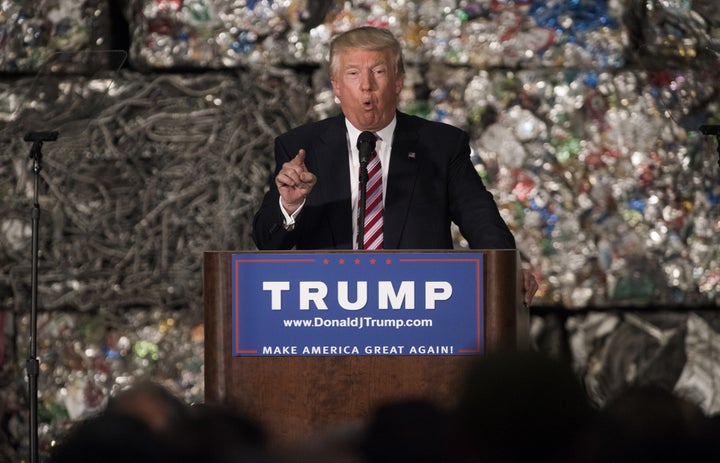
While his management of Trump University and his long-standing habit of stiffing small-business contractors should be enough to discredit Donald Trump’s recent efforts to claim himself as a warrior for the little guy against the financial elites, consider his most detailed economic proposal: his tax plan.
Earlier in the campaign, Trump boldly tried to distance himself from Republican orthodoxy on cutting taxes even for the most well-off Americans, by stating that “hedge fund managers get away with murder” when it comes to taxes and the very well-off like himself “will pay more.” Trump received significant praise in major papers last October for these populist statements largely because he seemed to be backing it up with a specific proposal: eliminate the carried interest loophole that allows some hedge fund and private equity managers to pay a lower 23.8% capital gains rate on what many even in the financial sector consider ordinary income normally subject to a top rate of 39.6%. Trump’s proposal was seen to have symbolic power for at least displaying a willingness to call for higher taxes on at least a small class of well-off financial players.
After receiving some initial media praise for his proposals, follow-up news reports started to explain that this proposal might be more of a nothing-burger: some in the press started to report that hedge fund and private equity managers receiving carried interest income would in fact see their rates raised from 23.8% to only 25% – Trump’s stated top income rate. But even here, too many failed to read the finer print that revealed that Trump’s tax plan called for virtually all business income – even outside of corporations – to be taxed at only a 15% rate. This would apply to any and all “business income” ranging from so-called Schedule C income to S-Corp income to partnership income. Just read what the independent, non-partisan Tax Policy Center (TPC) wrote: “Under the Trump plan, [carried interest] income would be taxed at a top rate of 15 percent, a reduction of more than one-third.”
“Trump’s tax plan would give more tax relief to the top 1/10th of 1% than the bottom 60% of Americans combined.”
So who would that apply to? Those receiving this massive tax break would include partners in big law firms, D.C. lobbyists, and real estate tycoons like perhaps Donald Trump. And oh, yes, that would also include the very hedge fund and private equity managers Trump had claimed got away with murder and were “going to pay more” under his plan.
Under Trump’s plan anyone in the top 1% of Americans with business income would see their top marginal rate fall all the way from 39.6% to 15%. And those getting away with murder on carried interest? Their sentence was to have their tax rates lowered from 23.8% to 15% -- a tax cut of more than one-third. With a bit more light, Trump’s tax plan suddenly looked more Howard Hughes than Huey Long.
But the false advertising goes far deeper than the deception that hedge fund managers getting carried interest would “pay more.” Far from cutting a new piece of cloth on Republican tax fairness, Trump’s stands out for both the magnitude of its tilt toward the very most well off Americans. Trump’s tax plan would give more tax relief to the top 1/10 of 1% than the bottom 60% of Americans combined. And remarkably, the top 1% would get about as much tax relief as the bottom 90% of Americans combined.
And yet, it gets worse. There is almost no question that the TPC’s analysis is actually too kind to the Trump plan and underestimates how regressive and unfair the Trump tax plan is. Why? Because the TPC analysis assumes that those high-income workers who are currently in partnerships, S-Corps or getting other types of business income will be the only ones who will benefit from the 15% rate. Yet, that assumption is not close to realistic. While the IRS could perhaps catch someone clear instances of tax avoidance, there is no possible way that even a well-funded IRS could over time stop millions of high-income Americans from using their lawyers and accountants to reorganize the form of their work to as partnerships and consultancies to get the lower 15% rate. Therefore, as regressive as the TPC results are, the actual plan would clearly be worse.
Then there is the issue of the size of Trump’s tax cut and who would bear the burden of his recklessness and carelessness. The TPC has estimated that Trump’s plan would raise the national debt by a staggering $34 trillion over 20 years. There is no conceivable strategy for paying for his tax cut without the burden falling overwhelming on the backs of poor and middle class Americans. Any serious effort to keep such a massive tax cut for the well-off deficit neutral as Trump’s advisors have promised would include dramatic cuts to Medicare, Social Security and Medicaid. While Trump claims he would avoid cutting Medicare and Social Security, analysis from both the Committee for a Responsible Federal Budget (CRFB) and Center for Budget and Policy Priorities (CBPP) have shown how completely infeasible that promise would be. The CRFB analysis shows that paying for Trump’s tax without hitting Medicare or Social Security would mean cutting all of the rest of government by an implausible 39% -- including national defense. If you protect defense, the cuts grow to 53% according to the CPBB. To be clear, that would mean that all Medicaid – from health care for low-income families to Americans with serious disabilities and older Americans in nursing homes – as well as all Veterans’ benefits, homeland security, education, FBI, air traffic safety – you name it would be cut approximately in half. Try to exempt more programs and the cuts to the remaining benefits and services and protections to working Americans just get absurdly deeper and deeper.
Indeed, the Trump tax plan seems perfectly designed to exacerbate rising income inequality and stagnant middle class wages. Simply put, under Trump’s plan if a single adult construction worker making, say, $60,000 got a $5,000 Christmas bonus from his employer, he would pay at least a 20% tax on that bonus. Yet, under Trump, a successful hedge fund manager who nets a cool $5 million end-of-year bonus would actually pay a lower 15% rate on it. And note the well-off investment professional would be paying less on his bonus that the middle-class worker not because of complex tax avoidance, but because that is the unambiguous design of Donald Trump’s tax plan: It specifically set a higher tax rate for a single adult making over around $55,000 than for someone making millions per year in business income.
“The Trump tax plan seems perfectly designed to exacerbate rising income inequality and stagnant middle class wages.”
Finally, at a time when there is more and more focus on not just unacceptable income inequality but disturbing degrees of wealth inequality, the Trump plan might as well be dubbed the Downton Abbey tax cut. Trump would completely eliminate the estate tax even for our nation’s largest fortunes while maintaining the stepped-up basis for capital gains, meaning that families with vast fortunes could permanently avoid paying taxes on huge amounts of wealth that they amassed simply by passing on to heir heirs stocks, real estate, and other assets whose values had risen significantly. So for example, a billionaire real estate tycoon could turn over vast fortunes of assets to his children that had increased in value by hundreds of millions of dollars with absolutely no one ever paying a penny of taxes. Far more successful and civic-minded billionaires like Bill Gates and Warren Buffett have railed against even the status quo estate tax regime as inconsistent with American values. This goes disturbingly further.
Just last month, when criticized for the massive debt increase and unfairness of his tax plan, Trump nixed an effort by some outside advisors to alter what is his most detailed economic proposal so far. So, despite his tax plan being at complete odds with his rhetoric, as we have seen in some of his private dealings, Mr. Trump clearly thinks false advertising is a better solution than actually fixing the problematic substance of his offerings.
